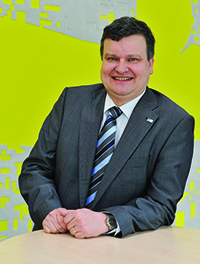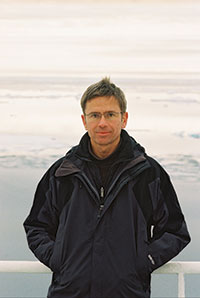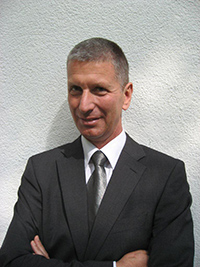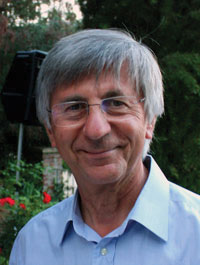
KEYNOTE ON "THE PROPAGATION APPROACH FOR COMPUTING BIOCHEMICAL REACTION NETWORKS"
ABSTRACT
Joint work with Maria Mateescu.
Propagation models provide a framework for describing algorithms for the transient analysis of stochastic state transition systems, such as computing event probabilities, expectancies, and variances on biochemical reaction networks. We discuss the syntax, semantics, and pragmatics of propagation models. We give three use cases for propagation models: the chemical master equation, the reaction rate equation, and a hybrid method that combines these two equations. We present a propagation abstract data type (ADT) for implementing uniformization and integration algorithms on propagation models. The propagation ADT is based on an update operator, which propagates continuous mass values through a discrete state space. The update operator can be implemented using a threshold abstraction, which propagates only "significant" mass values and thus achieves a controllable compromise between efficiency and accuracy.
AUTHOR BIOGRAPHIES
Thomas A. Henzinger is President of IST Austria in Klosterneuburg, Austria. He holds a Dipl.-Ing. Degree in Computer Science from Kepler University in Linz, Austria, an M.S. degree in Computer and Information Sciences from the University of Delaware, and a Ph.D. degree in Computer Science from Stanford University (1991). He was Assistant Professor of Computer Science at Cornell University (1992-95), Assistant Professor (1996-97), Associate Professor (1997-98), and Professor (1998-2004) of Electrical Engineering and Computer Sciences at the University of California, Berkeley, and Professor of Computer and Communication Sciences at EPFL in Lausanne, Switzerland(2004-09). He was also Director at the Max-Planck Institute for Computer Science in Saarbruecken, Germany (1999). His research focuses on modern systems theory, especially models, algorithms, and tools for the design and verification of reliable software, hardware, and embedded systems. His HyTech tool was the first model checker for mixed discrete-continuous systems. He is an ISI highly cited researcher, a member of Academia Europaea, a member of the German Academy of Sciences (Leopoldina), a member of the Austrian Academy of Sciences, a Fellow of the ACM, and a Fellow of the IEEE.

KEYNOTE ON "CLIMATE CHANGE - STATE OF THE SCIENCE”
ABSTRACT
We are in the midst of a major global warming, as witnessed not just by temperature measurements, but also for example by the record loss of Arctic sea ice in recent years. In the year 2008, both the Northwest Passage and the Northeast Passage in the Arctic were open for ships to pass through for the first time in living memory. Satellite data show that the huge ice sheets in Greenland and Antarctica are losing mass at an accelerating pace. What are the causes of this warming? How much warming must we expect in fu-ture? How does it affect sea level, extreme events and other aspects of the climate system? And can we stop this warming, and how? These topics will be discussed based on the most recent data and climate simulations.
AUTHOR BIOGRAPHIES
After studying physics at the Universities of Ulm and Konstanz and physical oceanography at the Univer-sity of Wales (Bangor) Stefan Rahmstorf completed a thesis on general relativity theory. He then moved to New Zealand and obtained his PhD in oceanography at Victoria University of Wellington in 1990. His PhD work included a number of research cruises in the South Pacific.
After this he worked as a scientist at the New Zealand Oceanographic Institute, at the Institute of Ma-rine Science in Kiel and since 1996 at the Potsdam Institute for Climate Impact Research. His work there focuses on the role of the oceans in climate change.
In 1999 Rahmstorf was awarded the $ 1 million Centennial Fellowship Award of the US-based James S. McDonnell foundation. Since 2000 he teaches Physics of the Oceans as a professor at Potsdam Univer-sity. Rahmstorf is a member of the Academia Europaea and of the German Advisory Council on Global Change (WBGU). He was also one of the lead authors of the 4th Assessment Report of the IPCC. In 2007 he became an Honorary Fellow of the University of Wales and in 2010 a Fellow of the American Geo-physical Union.
He has published over 80 scientific papers (20 of which in the leading journals Nature, Science and PNAS) and co-authored four books. Available in English is Our Threatened Oceans (2009, with Kathe-rine Richardson) and The Climate Crisis (2010, with David Archer).

MASM KEYNOTE
ABSTRACT
Supply Chain Management in the Semiconductor Industry: Successes and Challenges Dr. Kurt Gruber focuses in his speech on the challenges of a global Supply Chain network from supplier's supplier to customer's customer, the aspiration to reach a robust, crisis proven Supply Chain with "zero defects" and the flexibility answer as forecasts never reflect reality. The need of simulation for those challenges as well as the status will be shared.
AUTHOR BIOGRAPHIES
Dr. Gruber has over 25 years of semiconductor experience and heads Infineon's Corporate Supply Chain. His department is responsible for global demand fulfillment and logistics operations, manages the internal and external production networks and drives the development of Infineon's supply chain and production strategies. Dr. Gruber received his Ph.D. in Mathematics at the Technical University of Graz, Austria. Infineon Technologies provides semiconductor and system solutions, focusing on three central needs of our modern society: Energy Efficiency, Mobility and Security. It's Germany's largest semiconductor company. Infineon won recently several supply chain awards.

TITANS TALK ON "MODELING AND SIMULATION OF COMPLEX SYSTEMS: ARE PETRI NETS USEFUL?"
ABSTRACT
Modeling and analysis of complex systems is becoming increasingly popular due to the availability of powerful processors and the possibility of distributing the analysis over a large set of cooperating computers. Within this context, simulation is often the method of choice for studying the validity of a model and for deriving reliable indications on the efficiency and the effectiveness of the system under study. Despite the power of the machines used for these analyses, the complexity of the models often exceeds the capabilities of direct simulation methods and techniques must be developed to exploit the structure of the model to derive faster simulation algorithms and to obtain reliable performance indications. Petri nets (PNS) are a formalism which allows a precise representation of the intricacy of modern systems and thus of the interactions among different system components characterized by internal complex functionalities with a very well defined semantics. In this paper we will discuss the properties of PNs that are useful for a preliminary qualitative validation of the model and we will show how the PN representation can be easily exploited to gain a reasonable confidence about the correctness of the model. Moreover, we will discuss the possibility of using the structure of the PN model to perform multi-scale analysis of systems with many components characterized by large speed differences. Examples from Systems Biology and from immunology will be used to support the arguments discussed in the paper.
AUTHOR BIOGRAPHIES
Gianfranco Balbo is Professor of Computer Science at the University of Torino, Italy. He received a MS and Ph.D. in Computer Science from Purdue University (USA), with a specialization in operating systems and evaluation methods for the study of their performances. His research interests are in the area of performance evaluation of computer systems, queueing network models, stochastic Petri nets, and queueing theory. After working on the computational algorithms for the solution of product form queueing networks, he started to use Stochastic Petri Nets for the analysis of the performance of parallel computers. In 1984, together with M. Ajmone-Marsan and G. Conte, he proposed the Generalized Stochastic Petri Net (GSPN) formalism which, supported by the GreatSPN software package, quickly became one of the most popular modelling languages for the specification and analysis of performance and reliability models of computer and communication systems. He has published over 70 scientific papers and co-authored three books. He is an ISI highly cited researcher, a member of the Academy of Sciences of Torino, and a member of the ACM.